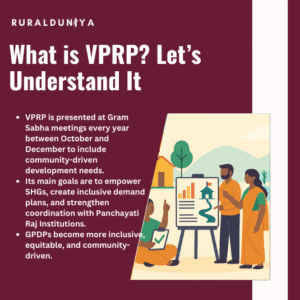Rural health is a crucial aspect of public healthcare that focuses on addressing medical needs in non-urban areas. It encompasses challenges related to accessibility, affordability, and quality of healthcare services.
Despite significant policy interventions, it disparities persist worldwide, impacting millions of people. Ensuring equitable healthcare for rural populations is essential for overall national development, community well-being, and economic stability.
Rural Health: Bridging the Gap in Healthcare Access
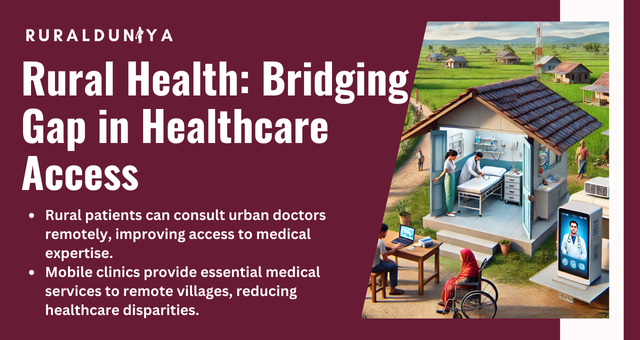
Rural health pertains to healthcare services, disease prevention, and medical access in villages and remote areas. Unlike urban health facilities, healthcare often suffers from inadequate infrastructure, fewer medical professionals, and limited availability of essential medicines.
Governments and international agencies have made efforts to bridge the urban-rural healthcare divide, yet a vast gap remains in many developing nations. Sustainable healthcare policies, community health initiatives, and technological advancements such as telemedicine in rural areas are crucial in improving it outcomes.
Definition of Rural Health
It refers to the physical, mental, and social well-being of individuals residing in rural areas, where healthcare services are often scarce.
It encompasses preventive, curative, and emergency medical services while addressing challenges like distance barriers, lower income levels, and a lack of specialized healthcare facilities. Rural primary healthcare centers play a vital role in ensuring accessible medical care.
Rural Healthcare in India
India, with over 65% of its population residing in rural areas, faces significant health challenges. The country has made strides through initiatives like Ayushman Bharat and the National Rural Health Mission (NRHM), but disparities in access to primary healthcare still persist.
According to the Rural Health Statistics (RHS) 2022, India has a shortage of over 83% of specialists in Community Health Centers (CHCs) and a shortfall of 13% in primary health centers (PHCs). Public health interventions in rural India are critical to overcoming these gaps.
Rural Health Mission
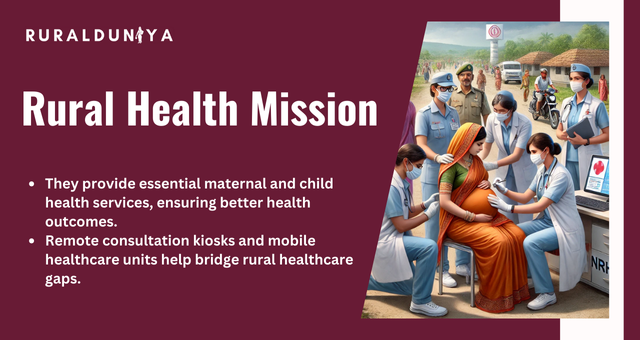
The National Rural Health Mission (NRHM) was launched in 2005 to strengthen healthcare by improving infrastructure, workforce availability, and service quality.
Under NRHM, initiatives like Accredited Social Health Activists (ASHAs) and Auxiliary Nurse Midwives (ANMs) have improved maternal and child healthcare services in rural areas. This programs continue to evolve with enhanced policies and digital health solutions.
Rural Healthcare System
The Indian rural healthcare system comprises three-tiered healthcare facilities:
- Sub-Centers (SCs): First point of contact for healthcare in rural areas, catering to populations of 3,000-5,000.
- Primary Health Centers (PHCs): Serve as referral units for six sub-centers, providing curative, preventive, and family welfare services.
- Community Health Centers (CHCs): Provide specialized services and cater to approximately 120,000 people.
Rural Health Statistics
- Infant Mortality Rate (IMR): Rural IMR in India stands at 34 per 1,000 live births, while in urban areas, it is 20 per 1,000 live births (Sample Registration System 2022).
- Maternal Mortality Rate (MMR): The rural MMR is 130 per 100,000 live births, significantly higher than urban MMR.
- Doctor-to-Patient Ratio: In rural India, there is one doctor for every 10,926 people, while the WHO recommends one doctor per 1,000 people.
- Sanitation and Hygiene in Rural Areas: Open defecation rates remain high, leading to waterborne diseases.
Importance of Rural Health
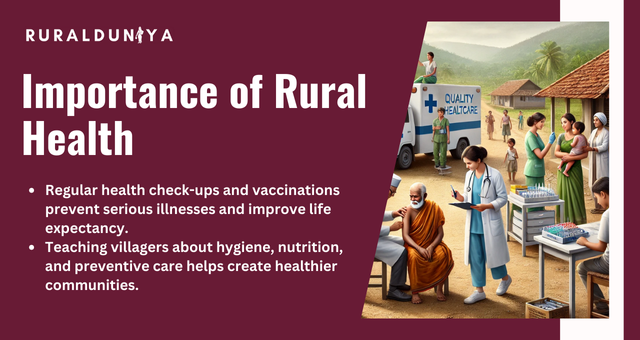
Access to quality healthcare in rural areas is critical for improving life expectancy, reducing mortality rates, and enhancing economic productivity.
A robust healthcare system ensures early disease detection, better maternal and child health, and overall community well-being. Preventive healthcare in rural areas is crucial to managing outbreaks and improving overall health indicators.
Causes of Rural Health Problems
- Lack of Healthcare Infrastructure: Poorly equipped medical facilities and a shortage of healthcare workers.
- Low Literacy Rates: Limited health awareness and knowledge about preventive measures.
- Economic Barriers: Inability to afford healthcare expenses.
- Geographical Challenges: Remote locations hinder access to timely medical intervention.
- Sanitation Issues: Poor hygiene contributes to the spread of communicable diseases.
- Malnutrition in Rural Communities: A leading cause of childhood stunting and related illnesses.
Rural Health Workers
Healthcare professionals in rural areas include:
- ASHAs (Accredited Social Health Activists): Community health workers promoting maternal and child health.
- ANMs (Auxiliary Nurse Midwives): Providing maternal healthcare and immunization.
- Doctors and Nurses: Often on rotational postings in PHCs and CHCs.
- Traditional Healers: In some remote regions, traditional medicine is still widely used.
Rural Health Education
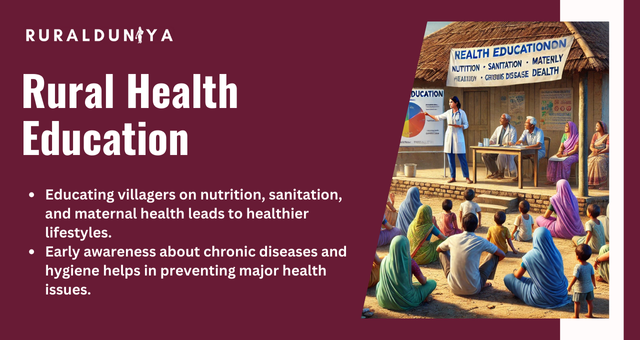
Health education plays a pivotal role in disease prevention and health promotion. Awareness programs on nutrition, sanitation, maternal health, and chronic diseases are essential to improve health literacy.
Health awareness campaigns in rural India have been effective in spreading preventive healthcare measures.
Rural Health Enterprises
Entrepreneurs and NGOs are stepping up to address healthcare gaps through:
- Telemedicine Initiatives: Expanding doctor consultations via digital platforms.
- Affordable Diagnostics: Mobile clinics and low-cost diagnostic solutions.
- Public-Private Partnerships: Leveraging private sector expertise to enhance healthcare delivery.
Rural Health Unit in the Philippines
In the Philippines, Rural Health Units (RHUs) serve as primary healthcare providers at the community level. They offer immunization, maternal care, and disease control programs under the supervision of the Department of Health (DOH).
The country’s Barangay Health Workers (BHWs) play a crucial role in delivering healthcare at the grassroots level.
Rural Health Infrastructure
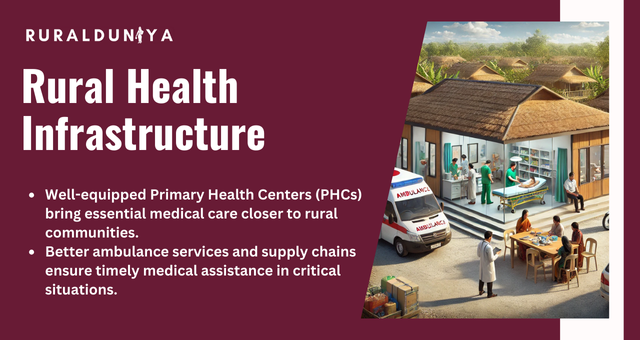
Developing health infrastructure involves:
- Establishing well-equipped Primary Health Centers and Sub-Centers.
- Enhancing ambulance and emergency response systems.
- Encouraging public-private partnerships for advanced healthcare solutions.
- Strengthening medical supply chains for timely availability of essential medicines.
Rural Health Issues
Major issues include:
- High infant and maternal mortality rates.
- Communicable diseases like tuberculosis, malaria, and diarrheal infections.
- Non-communicable diseases (NCDs) such as diabetes and hypertension.
- Mental health challenges due to a lack of awareness and stigma.
Rural Health Nutrition and Sanitation
Poor nutrition and sanitation are major contributors to health issues in rural areas. Data from NFHS-5 shows that 35.5% of rural children under five are stunted due to malnutrition.
Open defecation remains a challenge, although Swachh Bharat Abhiyan has significantly improved sanitation coverage. Rural nutrition programs like mid-day meal schemes help improve child health outcomes.
Last Words
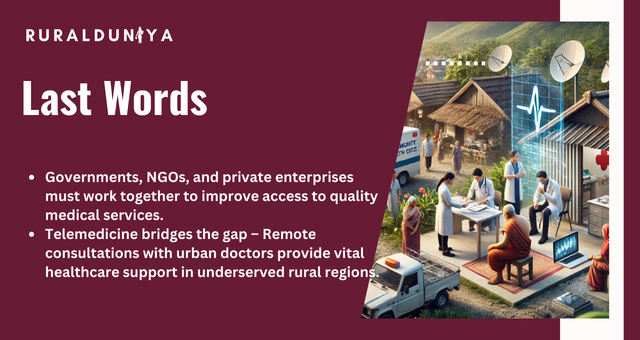
Rural health remains a critical public health challenge worldwide, with infrastructure gaps, workforce shortages, and economic barriers limiting access to quality care.
Governments, NGOs, and private enterprises must work together to strengthen healthcare systems, invest in telemedicine, and ensure equitable health services for all. By prioritizing health in rural areas, nations can pave the way for a healthier and more prosperous future for their citizens.
Community-based healthcare solutions will play a key role in achieving sustainable health improvements in rural areas.
FAQs
What are the biggest challenges in rural healthcare?
The main challenges include a shortage of doctors, lack of hospitals, poor infrastructure, high treatment costs, and difficulty in reaching medical facilities.
How can rural healthcare be improved?
It can improve through better government policies, mobile health clinics, telemedicine, trained community health workers, and stronger sanitation programs.
Why is rural healthcare important?
Good healthcare reduces diseases, lowers death rates, improves life quality, and helps people live healthier and more productive lives.
What is the role of technology in rural healthcare?
Technology like telemedicine, mobile apps, and AI-powered diagnostics help doctors reach remote patients, improving access to medical care.

Nishank is a social impact enthusiast with a solid foundation in public policy, micro-enterprise, and agribusiness. Growing up in a farmer’s family has given him a profound connection to rural communities, fueling his passion to empower people towards self-reliance. He completed his undergraduate studies at the Delhi University and earned a master’s degree in Rural Management from National Institute of Rural Development & Panchayati Raj in Hyderabad.


